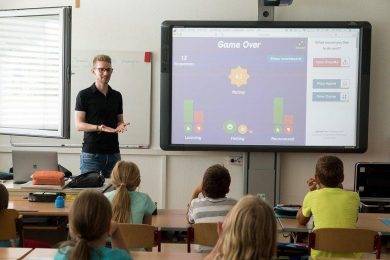After our parents, who are busy in upbringing and teaching us things about our surroundings, the next person we interact with for most of our lives is teachers. Our teachers have a substantial impact on our personalities and our life in general. Our confidence, self-esteem, and passion for learning new things come from how our teachers treat us or how much they motivate us. A teacher can help a student explore and open many doors. With the proper guidance and knowledge, a teacher can change a student’s life. No matter what jobs we have or where we are today, we still have some teachers alive in our memories who have helped us become the best version of ourselves.
Teacher leadership is one of the central factors in improving education and the school environment. Teaching methodologies and lesson delivery play a significant role in our learning. A teacher can make a challenging lesson easy or turn a simple mathematical sum into a complex one, depending on their teaching methods. Every teacher is a leader of their classroom as they are sailing the boat and streamlining learning direction. Teachers lead by example and the way they act in front of their students. Some teachers inspire us, and some make us run for our lives. Sad but true because this is how a teacher impacts teaching and learning practices.
Leadership In The Teaching System
A teacher has the command and control of reshaping a kid’s learning experience. Learning is an unending process, and it never ceases. A student learns a lot inside and outside classrooms, and they see and observe teachers throughout their academic learning years. Teachers’ leadership styles in education play a vital role in giving the right direction to teaching and learning practices in an educational organization.
This article will focus on how teacher leadership can promote effective teaching and learning practices.
- Being constructive
The U.S department of education promotes strong and effective teacher leadership. It is crucial in fostering systemic and sustainable education goals. Teachers have the responsibility of constructing a child’s future and their attitude towards it through their teachings. As a leader, a teacher can facilitate and engage learning leaders, redirecting their focus towards a constructing teaching and learning approach. Instead of forcing others to work in limitations, they value and consider others’ opinions and the knowledge they possess. Doing so allows learners to participate more in learning activities. It piques their interest more towards learning and sharing information.
Constructive teacher leadership allows students to be in charge of their learning. It also allows them to learn and explore things outside their classroom.
- Distributing equally
Every school or any other educational institute has policies and procedures to streamline its system. Distributed leadership among teachers or students promotes a shared sense of responsibility among teachers and students. Delegating the responsibilities among students make them feel valued, and it helps them understand sharing responsibilities. A teacher can create plentiful opportunities within their classroom for everyone to take a leadership role. Creating distributed leadership culture fosters a positive relationship among teachers and students. It also endorses collaboration and teamwork among students and teachers, leaving a positive impact on teaching and learning practices.
- Providing transactions
Enabling swift transactions through their teaching methodologies can help teachers to promote a give-and-take concept among students. Following a transactional leadership approach, teachers can stabilize performance-based reward systems. This transactional approach is ideal for students to enhance their performance through their assignments and assessments. Establishing smooth transactions can facilitate students to adapt to upcoming changes that can affect their learning practices. Training students to respond to transactions while giving them a heads up will help them adjust to sudden changes in their later academic years.
- Inviting environment
We all remember the excitement of volunteering for something when our teacher asked, “Who wants to help me?” Every student will raise their hand to take charge of the responsibility. Inviting students to take charge or shoulder a responsibility initiates an invitational leadership approach in the classroom. Creating strategies for teachers and students that invite everyone to learn and share what they know creates an effective learning environment for everyone. Teachers can facilitate each other by helping and sharing their experiences with others. Students can help their peers in their studies. Creating an inviting environment in the class encourages every student to participate, thus breaking all the barriers of shyness or self-esteem that hinder them from coming forward.
- Promoting emotional stability
We all focus and give importance to IQ. However, emotional intelligence also plays a significant role in teachers’ and students’ teaching and learning practices. Effective teacher leadership can promote students’ emotional stability, and it can garner knowledge through studying their emotions. Students and teenagers are emotionally sensitive, and slight disturbance can affect their positive emotions affecting their studies in the long run. Emotional teacher leaders motivate and inspire students to do better and blossom to their full potential. They focus on the emotional health of students to help them move forward through their academic years.
Conclusion
Teachers share a long-lasting bond with students. Even after years, students always remember the teacher who positively and negatively impacted their lives. Teacher leadership can improve and enhance the productivity of their students and colleagues. Creating inclusive communities where everyone can showcase their skills and potentials offer students a great learning opportunity and understanding their learning practices.
I am Jones Smith and I am here to share my experience and expertise in writing. I’ve been writing articles for different publications for more than 6 years. I have a varied range of interests and that’s why I love blogging about different topics. In my opinion, blogging is a lot like acting, and I consider writing blog posts as an acting job. I am an entrepreneur by heart and there is nothing big or small when it comes to starting a business.











